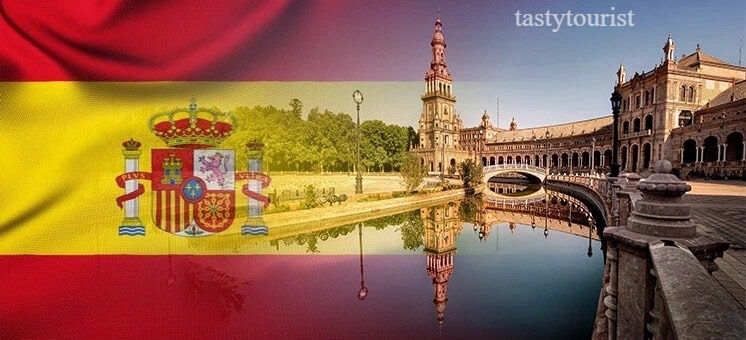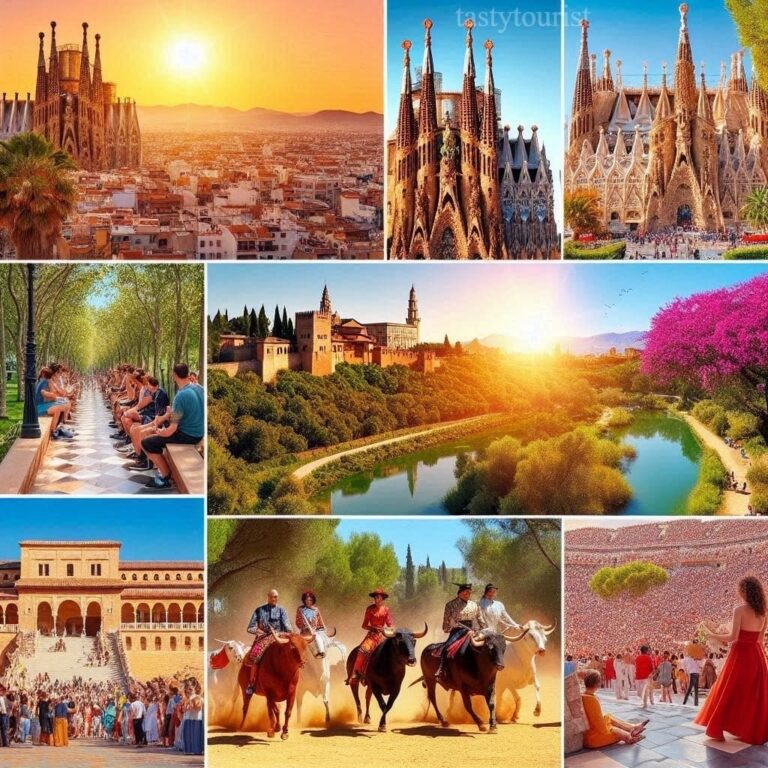Spain travel guide

Spain is a mix of old and new , modern and traditional . Renowned for lively festivals like Seville’s Feria de Abril and Buñol’s La Tomatina, Spain celebrates with music, dance, and communal joy.
On the tastytourist website, we briefly and usefully explain important points for traveling to Spain, such as the weather, the best time to travel to Spain, Spanish food and souvenirs, transportation, and etc…
Travel to spain
in many ways travelling to Spain is one of the most ideal vacation options and it’s not surprising for the second most country in the world
Located in southwestern Europe, sharing borders with Portugal to the west, France and Andorra to the northeast, and Gibraltar to the south. Additionally, Spain boasts several archipelagos, such as the Balearic Islands in the Mediterranean and the Canary Islands off the northwest coast of Africa.
With a population of approximately 47 million people, Spain is the fourth most populous country in the European Union. Safety is a significant consideration for travelers, and Spain is generally regarded as a safe destination.
The country has a well-developed infrastructure, efficient public transportation, and a robust healthcare system.
travel to Spain cities

Travel to Spain’s vibrant cities like Madrid, Barcelona, and more offers diverse cultural experiences. Madrid, the capital, boasts world-class art museums like the Prado and vibrant nightlife in Gran Vía. Barcelona impresses with Gaudí’s architectural marvels like Sagrada Família and lively markets.
Explore Seville’s rich history through its Moorish architecture and flamenco dance, while Valencia delights with futuristic architecture and paella.
Bilbao captivates with the Guggenheim Museum’s contemporary art. Enjoy Spain’s Mediterranean beaches in Costa del Sol or Costa Brava.
Spain weather
Spain’s climate is diverse, with significant regional variations:
- Mediterranean Climate: Found along the coastal areas and Balearic Islands. Summers are hot and dry, while winters are mild and wet. Cities like Barcelona, Valencia, and Malaga experience this climate.
- Continental Climate: Dominant in the interior, especially on the central plateau. Summers are very hot, and winters are cold and dry. Madrid and Salamanca are examples.
- Oceanic Climate: Located in the northern coastal regions, such as the Basque Country, Galicia, and Cantabria. These areas have mild, rainy winters and cool summers. Cities like Bilbao and Santiago de Compostela have this climate.
When is the best time to travel to Spain?
Spring (from March to May) is an ideal time for a tour of Spain, and on the other hand, autumn (from September to November) is a quiet and suitable period. Spain’s attractions are extremely crowded during the high season (between July and August), and not everyone enjoys such crowds. In spring and autumn, the weather is moderate and pleasant, and in addition to being quieter, accommodation prices are also cheaper.
The best time for festivals in Spain
Spain is full of events, festivals, and joyful programs throughout the year. However, spring and summer are more abundant in this regard, especially summer being the high season. If you can handle the difficulty of booking tickets and flights and the higher prices and the summer heat, you will experience one of the best trips of your life. Therefore, before traveling to any part of Spain, do thorough research, and if you’re not interested in participating in festivals, avoid this time of year.
Spanish food
Spanish cuisine is renowned for its diversity and rich flavors.
Tapas include various dishes like olives, onions, fish, meats, and chicken.
Paella, a local favorite, features rice, fish, shrimp, chicken, and vegetables.
Tortilla Española, made with fresh eggs, cooked in olive oil, and potatoes, is another popular dish.

- Spanish Fans (Abanicos): These beautifully crafted fans are not only practical but also artistic, often adorned with intricate designs or flamenco motifs. They make for a stylish accessory and a functional reminder of Spanish culture.
- Flamenco Accessories: Items like castanets (castañuelas), flamenco shawls (mantones de Manila), and flamenco dresses (trajes de flamenco) are iconic symbols of Spain’s passionate dance tradition. They reflect the country’s artistic flair and are cherished by enthusiasts worldwide.
- Spanish Ceramics: Spain is renowned for its colorful and ornate ceramics, such as Talavera pottery from Toledo or Andalusian ceramics from Granada and Seville. These hand-painted pieces often feature intricate geometric patterns or vibrant floral designs, perfect for home decor.
- Spanish Leather Goods: Leather products like handbags, wallets, and belts crafted from high-quality Spanish leather are popular souvenirs. Cities like Madrid and Ubrique are known for their skilled leather artisans who produce timeless pieces.
- Spanish Wine and Olive Oil: Spain is one of the world’s largest producers of wine and olive oil. Bottles of Rioja, Ribera del Duero, or Albariño wines make excellent gifts, as do bottles of extra virgin olive oil from regions like Andalusia or Catalonia.
- Iberian Ham (Jamón): Considered a gourmet delicacy, Jamón Ibérico or Jamón Serrano is a must-try and a coveted souvenir for food lovers. Vacuum-sealed packs of sliced ham or whole legs (paletas or jamones) can be found in specialty shops.
- Spanish Sweets and Treats: Turron (nougat), polvorones (shortbread cookies), and churros are delicious treats to bring back from Spain. Turron comes in various flavors like almond or chocolate and is a traditional holiday dessert.
- Spanish Handcrafted Jewelry: Pieces inspired by Moorish or Roman designs are popular. Filigree silverwork from Toledo or Valencia’s traditional jewelry designs are sought after.
- Spanish Books and Art: Works by Spanish authors or local artists are meaningful souvenirs. Books by Cervantes or contemporary Spanish literature, along with artwork depicting scenes from Spain’s landscapes or cities, are treasured keepsakes.
- Bullfighting Memorabilia: Though controversial, items like bullfighting posters, figurines, or capes (muletas) represent a significant aspect of Spanish culture and history.
Spain travel guide offers a range of hotels catering to various budgets and preferences:
- Economic/Budget Hotels:
- Hostal Central
- Mid-range Hotels:
- NH Hotels
- Meliá Hotels
- Boutique Hotels
- Room Mate Hotels
- Vincci Hotels
- Luxury Hotels:
- Ritz-Carlton Abama
- Hotel Arts Barcelona
- Gran Meliá Palacio de los Duques
Transportation in Spain offers efficient options for travelers to explore the country’s diverse landscapes and cities:
- Trains: Renfe operates Spain’s extensive train network, connecting major cities like Madrid, Barcelona, Seville, and Valencia. High-speed AVE trains are fast and comfortable, ideal for longer journeys. Regional trains provide slower but more economical options, reaching smaller towns and villages.
- Metro and Urban Transport: Major cities like Madrid, Barcelona, and Valencia have comprehensive metro systems that are efficient for getting around within the city. Buses, trams, and taxis complement metro services, offering convenient access to tourist attractions and neighborhoods.
- Buses: Inter-city buses operated by companies like ALSA and Avanza provide economical and extensive routes connecting cities and towns across Spain. Buses are often a practical choice for destinations not directly served by trains.
- Rental Cars: Renting a car is ideal for exploring rural areas, coastal towns, and regions like Andalusia or Galicia. Major car rental companies operate at airports and city centers, offering flexibility for travelers.
- Flights: Domestic flights are available between major cities for travelers needing to cover long distances quickly. Airlines like Iberia and Vueling operate frequent flights connecting Madrid, Barcelona, Bilbao, and other major hubs.
- Taxis and Ride-Sharing: Taxis are readily available in cities and can be hailed on the street or booked through apps. Ride-sharing services like Uber operate in major cities, offering another convenient option for getting around.
- Cycling and Walking: Many Spanish cities are bike-friendly, with dedicated lanes and rental services available. Walking is also a great way to explore historic city centers and scenic areas.
To conclude
In the Spain travel guide, we have endeavored to answer your questions by categorizing tourists’ needs. Please bear in mind that petty crimes such as pickpocketing can occur, especially in touristy areas, but violent crime rates are low. The Spanish government and local authorities place great emphasis on maintaining security and ensuring that visitors can enjoy their trip with peace of mind. Additionally, if you have already traveled to Spain and have ideas and opinions about the travel guide, please share them with us.
